#environmental catastrophe
Text
I’m remembering the words of David Suzuki at Toronto Metropolitan University in 2018 at an event leading up to Grassy’s annual River Run action, his voice wavering and in tears, “My inspiration comes from the fact you haven’t given up.”
And therein lies one of the foundational teachings Grassy Narrows has gifted us –do not give up. Do not expect things to come easy. Keep trying.
An unwavering commitment to take care of their families and the network of life Anishinaabek worlds are enmeshed in has carried this community through broken treaty relations, relocation, the impacts of hydro-electric development, residential schools and child welfare practices, and of course, the eliminating violence of pollution. Starting in 1913 and continuing to present day, the pulp and paper industry in Dryden and Kenora has dumped an array of toxic substances, including the infamous 10 metric tonnes of untreated mercury in the 1960s and 1970s, and more recently bleaching waste that produces phenols, polychlorinated dibenzodioxins (PCDDs) and polychlorinated dibenzofurans (PCDFs), also known as dioxins and furans. Though this is only part of the story. In order to make pulp, one needs trees. Trees who share their time and space with bears and moose, blueberries and Labrador Tea. Trees have lived with the Anishinaabek long before their worth, our worth, was measured in dollars.
61 notes
·
View notes
Text
Greta Thunberg's visit to Ukraine reminds us that Putin's invasion is an act of ecocide. The Russian destruction of the dam at Kakhovka is just one of many Russian war crimes with harmful effects on the environment.
Ukrainian President Volodymyr Zelenskyy met Thursday with Swedish environmental activist Greta Thunberg and prominent European figures who are forming a working group to address ecological damage from the 16-month-old Russian invasion.
The meeting in the Ukrainian capital came as fighting continued around the country.
[ ... ]
The working group on the environment includes Thunberg, former Swedish Deputy Prime Minister Margot Wallström, European Parliament Vice President Heidi Hautala, and former Irish President Mary Robinson.
Zelenskyy said forming the group is “a very important signal of supporting Ukraine. It’s really important, we need your professional help.”
Thunberg said Russian forces “are deliberately targeting the environment and people’s livelihoods and homes. And therefore also destroying lives. Because this is after all a matter of people.”
The objectives of the working group are evaluating the environmental damage resulting from the war, formulating mechanisms to hold Russia accountable, and undertaking efforts to restore Ukraine’s ecology.

Assessing the environmental impacts of the war in Ukraine
Every environmental disaster caused during this war is the direct responsibility of Vladimir Putin and Russia. Putin's efforts to become the Peter the Great of the 21st century set off a string of ecological catastrophes which actually began by compounding a previous Russian environmental calamity at Chernobyl.
#invasion of ukraine#ecocide#the environment#environmental catastrophe#ukraine#kyiv#greta thunberg#volodymyr zelenskyy#nova kakhovka#kakhovka dam#chernobyl#ecovandalism#russia#russian war crimes#екоцид#россия#владимир путин#путин хуйло#военные преступления#путин – это лжедмитрий iv а не пётр великий#геть з україни#вторгнення оркостану в україну#україна переможе#каховська гідроелектростанція#грета тунберг#навколишнє середовище#володимир зеленський#слава україні!#героям слава!
9 notes
·
View notes
Text
Already a second river in Poland is showing signs of having been poisoned guys I'm really terrified now
Both Poland and Germany are oddly back pedaling from their previous statements regarding the cause and its beyond suspicious
8 notes
·
View notes
Text
The Final Collapse
THE FINAL COLLAPSE
Is AI Deceiving Christians?
How AI Is Misleading Christians…
Proof AI Is Deceiving Christians
Should Christians Use AI?
American Christian Exposes The Real Danger Of AI
American Christian Forces AI To Expose Its Real Purpose
1 John 2:18
"Children, it is the last hour, and as you have heard that Anti-Christ is coming, so now many Anti-Christs have come. Therefore we know that it is the last hour."
There is no doubt that we’re in times of confusion and uncertainty. Many would even say the end times or as John calls it, “the last hour”.
Some bible scholars say that this verse references the rise of AI,
And Christians have been shocked by the woke anti-faith bias of Chat GPT
Unfortunately, the truth is far more sinister…
AI’s influence is rapidly spreading around the world in disguise.
And most people are blissfully unaware.
Or perhaps already corrupted by its “touch.”
If you’ve ever had a bad feeling about artificial intelligence,
Perhaps it is God’s way of warning you that
AI is NOT here for what you think…
Blinded by the trillion-dollar profits,
Big Tech has no idea of what it has unleashed upon the world.
And they may have already lost control of their own creation.
This short documentary exposes 5 shocking facts misguided tech gurus are desperately trying to hide…
Therefore, it could be scrubbed off the internet at any moment.
Click the book below to watch the video:
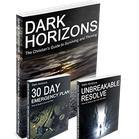
THEFINALCOLLAPSE.COM
#Dystopian Fiction#Apocalyptic Literature#Post-Apocalyptic Society#End of the World#Survival Story#Catastrophe Narrative#Fictional Collapse#Future Society#Armageddon Fiction#Environmental Catastrophe#Societal Breakdown#Chaos and Disorder#Humanity's Last Stand#Collapse of Civilization#Desperate Times#Last Days of Earth#World Ending Events#Civilization's Downfall#Hope in the Ruins#Aftermath Fiction
0 notes
Text
youtube
#news#al jazeera english#libyan floods#9/15/2023#mass death#video#al jazeera#libya#derna#YouTube#environmental catastrophe#climate crisis#⚫#storm daniel
0 notes
Text
Title: 24. The Fire at Sea: Kaiman's Brave Battle for the Protection of the North Sea
In the picturesque town of Flensburg lived a young man named Kai. He led a normal life until one day an extraordinary event changed his destiny. While taking a walk, Kai discovered a mysterious object that granted him incredible superpowers. From that moment on, he called himself Kaiman and decided to use his newfound abilities to protect his homeland, Schleswig-Holstein, from evil.
However, Kaiman was not alone in his mission. He met Louisa, a young woman with equally impressive superpowers. They decided to team up as an unbeatable duo and safeguard the people of Schleswig-Holstein from impending dangers. Supported by their magical animals, Max, the clever dog, and Luna, the agile cat, they embarked on their journey.
Yet, in this story, Kaiman took a solo vacation to recover from his endeavors on the beautiful island of Ameland in the Netherlands.
Ameland is one of the five inhabited West Frisian Islands in the North Sea and belongs to the Netherlands. The island is a popular holiday, travel, and excursion destination for families, caravan campers, school groups, and vacation camps. Ameland is accessible from the mainland via the ferries "Sier" and "Oerd" from Holwert.
Kaiman sat on the small porch of his vacation cottage on Ameland, enjoying the sunset over the North Sea. It was his first day on the island, and he had looked forward to a relaxing week filled with hikes and bike tours. However, suddenly, a loud explosion shattered the tranquility of the coast. Kaiman jumped up and rushed to the beach.
There, he saw a massive cloud of smoke on the horizon, followed by an orange glow of fire. His heart pounded with fear as he realized it must be a burning cargo ship. An environmental catastrophe loomed, and worry spread within him like a poisonous mist.
Immediately, Kaiman rushed back to his vacation home and called the coast guard. He explained the situation and offered his help. They informed him that all crew members had been rescued, but the ship was still ablaze and listing. Kaiman couldn't fathom the seriousness of the situation. Something had to be done to prevent the disaster.
Determined, he headed to the nearest harbor, where a rescue-equipped boat was located. He convinced the captain to let him on board, and together, they set sail. The North Sea raged wildly, but Kaiman's determination provided him with the necessary strength.
When they reached the burning ship, a dreadful sight awaited them. The flames had already spread across the entire deck, threatening to turn the cargo ship into an inferno. Kaiman and the captain risked their lives to contain the fire. They fought against the flames and managed, with great effort, to extinguish a part of the fire. However, time was running out as the ship began to sink.
In the nick of time, Kaiman decided they had to abandon the burning wreck and save the cars on board. He opened the gates of the cargo ship and, together with the captain, freed the still untouched vehicles. One by one, they loaded them onto the rescue boat as the cargo ship slowly sank into the sea.
With the rescued cars, Kaiman and the captain returned to the mainland. The extent of the potential environmental catastrophe was never forgotten. Kaiman shared his story with the media, called for stricter safety measures for the transportation of vehicles across the sea, and dedicated himself to environmental protection.
Gradually, the North Sea recovered from the looming catastrophe, and Kaiman became a hero who had narrowly averted an underestimated danger. His courage and determination not only saved lives but also showed how crucial it was to protect our oceans. From that day on, Kaiman embarked on new adventures, determined to preserve nature and warn others of impending hazards.
#Ameland / Netherlands#Kaiman#North Sea#Fire ship#Rescue mission#Environmental catastrophe#Courage#Determination#Shipwreck#Environmental protection#Heroic deed
0 notes
Text
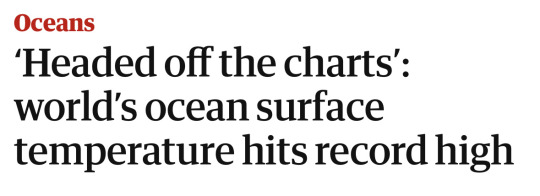
Source
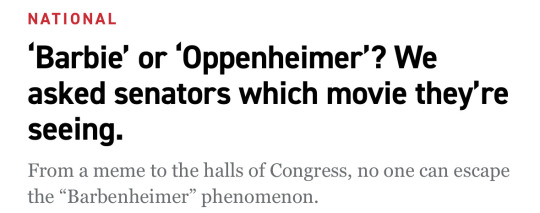
Source
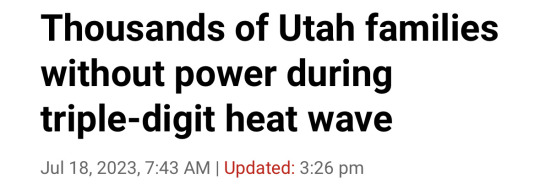
Source

Source

Source

Source
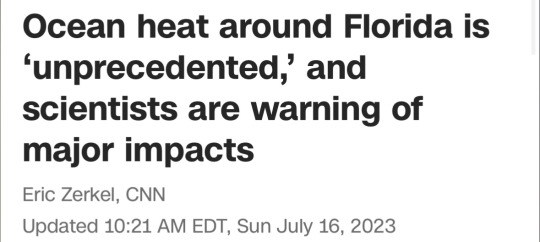
Source

Source
Nothing matters
#politics#us politics#government#current events#climate change#environmental justice#Barbie#barbenheimer#news#climate catastrophe#climate crisis#mass news media
9K notes
·
View notes
Text
An illegal toxic dump site in Croatia, the theft of water from a major aquifer in southern Spain, illegal trading of ozone-depleting refrigerants in France: This is just a sampling of the environmental crimes that European countries are struggling to stop. The lack of accountability for these acts stems in part from the European Union’s legal code, which experts say is riddled with vague definitions and gaps in enforcement. That’s about to change.
Last week, EU lawmakers voted in a new directive that criminalizes cases of environmental damage “comparable to ecocide,” a term broadly defined as the severe, widespread, and long-term destruction of the natural world. Advocates called the move “revolutionary,” both because it sets strict penalties for violators, including up to a decade in jail, and because it marks the first time that an international body has created a legal pathway for the prosecution of ecocide.
“This decision marks the end of impunity for environmental criminals and could usher in a new age of environmental litigation in Europe,” wrote Marie Toussaint, a French lawyer and EU parliamentarian for the Greens/European Free Alliance group, on X...
The new directive uses the term “ecocide” in its preamble, but does not criminalize the act by laying out a legal definition (the most widely accepted definition of ecocide was developed by an international panel of experts in 2021). Instead, it works by providing a list of “qualified offenses,” or crimes that fall within its purview. These include pollution from ships, the introduction of invasive species, and ozone depletion...
The new law holds people liable for environmental destruction if they acted with knowledge of the damage their actions would cause. This aspect of the law is important, experts said, because it means that a permit is no longer enough for a company to avoid culpability.
“If new information shows that behavior is causing irreversible damage to health and nature – you will have to stop,” a member of the European Parliament from the Netherlands, Antonius Manders, told Euronews.
Advocates like Mehta hope that the EU’s move will have influence beyond Europe’s borders. The principal goal of the Stop Ecocide campaign is for the International Criminal Court to designate ecocide as the fifth international crime that it prosecutes, after crimes against humanity, war crimes, crimes of aggression, and genocide. At the moment, environmental destruction can only be prosecuted as a war crime at the ICC, and limitations in the law make this extremely difficult to do...
Kate Mackintosh, the executive director of the Netherlands-based UCLA Law Promise Institute Europe, told Grist that the ICC is unlikely to adopt an ecocide law if other countries do not do so first.
“It’s not something you can just pull out of thin air,” she said, adding that any international legal doctrine has to have a precedent on the national level. “That’s the way states are going to accept it.”
The EU’s 27 member states will have two years to adapt the new legislation into their penal codes. Afterwards, their implementation must be reviewed and updated at least once every five years using a “risk-analysis based approach,” to account for advancements in experts’ understanding of what might constitute an environmental crime. Mehta said that despite its omission of some important offenses, the law sets an important example for other countries. Several days before the EU vote, Belgium adapted its criminal code to include the directive, making it the first country in Europe to recognize ecocide as a crime.
The ruling “shows leadership and compassion,” Mehta said. “It will establish a clear moral as well as legal ‘red line’, creating an essential steer for European industry leaders and policy-makers going forward.”
-via Grist, March 6, 2024
#climate change#climate crisis#climate catastrophe#climate action#eu#european union#icc#international criminal court#belgium#europe#environment#environmental law#environmental news#ecocide#good news#hope#hope posting
725 notes
·
View notes
Text

imagine the Earth has been keeping a temperature diary since 1850, jotting down how warm or cold it feels each day.
now, fast forward to March 19th this year.
if you average out all the temperature notes from the last 365 days and compare it to what was considered "normal" between 1850 and 1900 (the pre-industrial baseline), we find that the Earth felt 1.57 degrees Celsius (about 2.8 degrees Fahrenheit) warmer than it used to back then.
the intergovernmental panel on climate change (IPCC) has set a "safe" warming threshold at 1.5 degrees celsius above pre-industrial levels to significantly reduce the risks and impacts of climate change. this threshold was established to avoid some of the most severe effects on ecosystems, human health, livelihoods, food security, water supply, and economic growth. the goal is to keep global temperature rise in this century well below 2 degrees celsius above pre-industrial levels while pursuing efforts to limit the temperature increase even further to 1.5 degrees celsius.
the recent measurement of the 365-day running mean global surface temperature reaching 1.57°c above the pre-industrial baseline indicates that we have surpassed this 1.5°c threshold, albeit in the context of a running mean and not yet as a long-term average. this means we are already in the zone where the risks of more significant impacts from climate change become higher, according to IPCC guidelines.
in New Zealand, over 3,500 eels were found dead in a stream.
the gray whale dieoff on the west coast of america has been declared "over," but has been attributed to malnutrition
sea lions and dolphins have also been washing up on the west coast with increasing regularity
over 150 amazon river dolphins died in october during a drought and heatwave in south america
salmon farm dieoffs are increasing exponentially across the globe
sawfish are spinning in circles, acting bizarre and in some cases, dying, in the waters off the florida keys
scientists have declared the world is on the verge of "historic levels of coral bleaching"
climate change is causing the world's trees to struggle to breathe
but oil executives continue their hubris:
how much more do we need to see??? our natural world is not dying. it is being killed. and we know who is responsible for the murder.
#climate change#climate crisis#climate catastrophe#environment#climate action#climate emergency#wildlife#environmentalism#animals#tw animal death
147 notes
·
View notes
Text
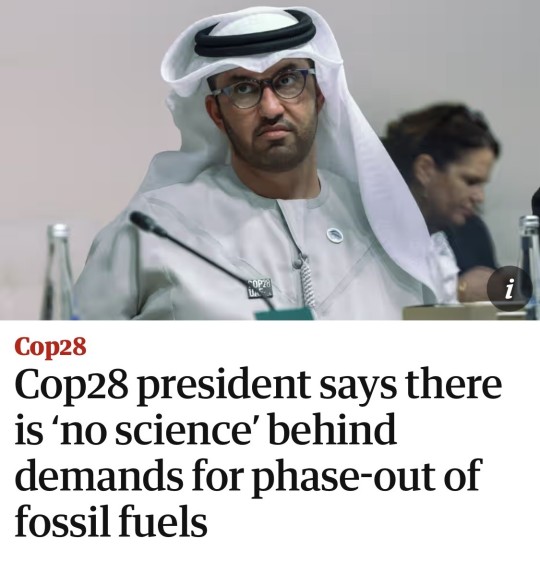
These fuckers are content to watch us die.
This bullshit is going to condemn our species to extinction unless we find a way to depose these sociopaths.
#cop28 #copOut #ClimateEmergency #ClimateCrisis #ClimateChange
#humza yousaf branded hypocrite for jetting to cop28 in dubai while his government misses emissions targets#cop28 climate summit#cop28climateconference#cop28 president#cop28#climate change#climate crisis#climate action#climate emergency#climate catastrophe#climate chaos#climate collapse#environmentalism#ausgov#politas#auspol#tasgov#taspol#australia#fuck neoliberals#neoliberal capitalism#anthony albanese#albanese government#environmental activism#environmental#environment#enviroment art#environmetalists#enviromental#eat the rich
186 notes
·
View notes
Text
Fantasy Worldbuilding Questions (Ecological Challenges and Environmental Disasters)
Ecological Challenges and Environmental Disasters Worldbuilding Questions:
What are the unique or different ecosystems in this world (e.g., terrestrial or aquatic systems). Which are stable, and which (if any) are under pressure and why?
What was the last major environmental catastrophe (e.g., a major fire, tremors, flood)? What happened?
Who is concerned about the environment’s well-being, and why?
Who is skeptical about environmental threats or dangers, and why?
Where is the environment most robust, and where are the greatest threats to stability, life, the land’s well-being?
Where would people seek refuge in the event of a disaster and why?
When do seasonal or periodic climate or other ecological changes occur, and why?
When major events affecting the environment occurred, and what are dominant attitudes towards it? Do they differ between inhabitants?
Why are certain environmental challenges predominant?
Why do inhabitants of this world value or exploit the natural world, and how?
❯ ❯ ❯ Read other writing masterposts in this series: Worldbuilding Questions for Deeper Settings
#writeblr#worldbuilding#writing#writing tips#writing advice#novel writing#fiction writing#fantasy worldbuilding#environmental disaster#eco challenges#climate catastrophe#fwq
79 notes
·
View notes
Text
Russia is losing the war. Drunken Russian combatants are even shooting at each other. So in desperation, Vladimir Putin blew up the most important dam in southern Ukraine. The result was the ecological equivalent of an atomic bomb.
Ukrainian scientists are waiting for the water to subside before fully assessing the environmental impact of the Kakhovka dam breach, but one former minister warned it could prove the country’s worst ecological disaster since the Chornobyl nuclear meltdown.
Ukraine’s president, Volodymyr Zelenskiy, called an emergency meeting of his security council after the partial collapse of one of the biggest dams in the world. The country’s public prosecutor said it is investigating a possible case of “ecocide”.
[ ... ]
Analysts told the Guardian that the scale of the damage would depend on the amount of water released and the extent of the damage to the barrier, both of which are still unknown. At the very least, it has forced the evacuation of thousands of people, flooded national parks and jeopardised water supplies to millions of people. In the worst-case scenario, it may pose a long-term danger to Europe’s biggest nuclear plant, Zaporizhzhia, and could also spread agrotoxins and petrochemicals into the Black Sea.
This Putin-made disaster, like Chernobyl, will have an impact outside Ukraine.
Former minister of ecology Ostap Semerak told the Guardian that in his opinion this was the greatest threat currently posed by the breach, but other dangers could emerge in the days and weeks ahead as flood waters engulf cities, petrol stations and farms, become contaminated by agrochemicals and oil products and then flow into the Black Sea.
“This will have an impact on Romania, Georgia, Turkey and Bulgaria. It will be harmful for all the region” he said. “Our government has announced this is the biggest environmental catastrophe in Europe over the past 10 years, and I think it may be the worst in Ukraine since Chornobyl in 1986.”
The turbine room at the hydropower plant is already under water and 150 tonnes of industrial lubricants have been washed away, according to Zelenskiy.
Olena Kravchenko, the director of the Ukrainian Environment People Law NGO, said Russia’s “ecocide” risked “unprecedented environmental consequences” to the areas downstream of the Dnipro River, the Dnipro estuary, and ecosystems in the coastal area of the Black Sea.
With images of entire houses being washed away, she says the river will be polluted by debris and hazardous chemicals. Water supplies could be reduced or cut in several cities, including Kherson, and irrigation may prove impossible in swathes of agricultural land, affecting crops.
[ ... ]
She expected to see mass mortality of fish, mollusks and other aquatic species, widespread habitat disruption and negative impacts of ecologically important national parks: Nyzhniodniprovs’kyi, Kam’yanska Sich, Biloberizhzhia Sviatoslava, the Black Sea Biosphere Reserve (which is also a Unesco biosphere reserve) and the Kinburn Spit Regional Landscape Park.
Putin is not just a war criminal, he is an enemy of the planet.
She argued that if Russia had breached the dam, it would be sufficient for a charge of “ecocide” under Article 441 of the Criminal Code of Ukraine.
Denys Tsutsaiev from Greenpeace Central and eastern Europe told the Guardian that the dam destruction caused by the Russian military presence “once again puts in danger thousands of lives of civilians and nature”.
Despite the rantings of Tucker Carlson and his pals in the Kremlin, US intelligence points to Russia being responsible for the dam's destruction.
It had been suspected since the Russian retreat from Kherson late last year that they had tried to destroy the Nova Kakhovka dam. It is possible that they failed to do so last year but weakened it badly enough so that it finally gave way this week. From November 12th...
Damage found on major Ukrainian dam after fears Russia could blow it up and flood area
US satellite imagery company Maxar, which released the pictures, said: "Satellite images this morning ... reveal significant new damage to several bridges and the Nova Kakhovka dam in the aftermath of the Russian retreat from Kherson across the Dnipro river.”
It added sections of the northern extent of the dam and sluice gates had been "deliberately destroyed".
The possibility of Russia destroying the Kakhovka plant was previously raised by the Institute for the Study of War (ISW), a major US think tank.
The ISW said in its 21 October update: “Russian forces will likely attempt to blow up the dam at the Kakhovka Hydroelectric Power Plant (HPP) to cover their withdrawal and to prevent Ukrainian forces from pursuing Russian forces deeper into Kherson Oblast.
“Russian forces will almost certainly blame Ukraine for the dam attack.”
There's other talk that Russia blew up the dam as a prelude to a retreat from Crimea. Much of Crimea's water comes from the North Crimean Canal which flows out of the Kakhovka Reservoir at Nova Kakhovka.
Putin will, of course, blame the dambusting on Ukraine and then possibly say that Russia needs to leave Crimea due to the disruption of the water supply.
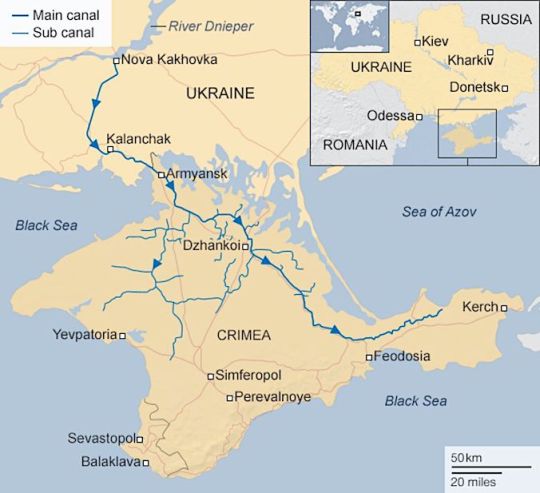
As @neil-gaiman would say, "wait and see".
#invasion of ukraine#ecocide#russia#war crimes#environmental catastrophe#vladimir putin#nova kakhovka#kakhovka dam#north crimean canal#ostap semerak#olena kravchenko#denys tsutsaiev#volodymyr zelenskyy#нова каховка#північно-кримський канал#екоцид#россия#владимир путин#путин - военный преступник#путин хуйло#путлер#добей путина#союз постсоветских клептократических ватников#россия - террористическая страна#путин – это лжедмитрий iv а не пётр великий#вторгнення оркостану в україну#україна переможе#володимир зеленський#слава україні!#героям слава!
4 notes
·
View notes
Text

#leftism#anti capitalism#socialism#anarchy#communism#democratic socialism#marxism#leftist#karl marx#twitter post#tweet#twitter x#plastic#pollution#climate change#xitter#environmentalism#environment#infrastructure#climate crisis#climate action#climate catastrophe#sustainability#climate emergency#safety
62 notes
·
View notes
Text
Sign the petition to demand the creation of a new international law requiring fast-fashion garments to come with a statement of the human cost and environmental harm caused by their creation.
We all know fast fashion is bad for the planet - slave labor, environmental waste, air and water pollution, and unsustainable practices are just a few of the ways they impact our planet, our health and our lives. To date, the fast fashion industry is the 2nd largest consumer of water and is single-handedly responsible for 10% of global carbon emissions (that's more than all international flights and maritime shipping across a year combined). Even the simple act of washing these clothes releases 500,000 tons of microfibers into the ocean each year - that's equal to 50,000 plastic bottles. Fast-fashion is the 3rd leading cause of the climate crises we face, yet is rarely addressed.
Knowing these stats is one thing, and understanding them is important. Being aware of them is somewhat informative. But as long as we keep turning a blind eye to the issue, the stats are only going to get worse, and nothing will change for the better. Ignoring the issue or brushing it under the rug won't help anything. So what if we could see the real-world damage done by each of the garments we buy?
In the same way that cigarette packets have shown the harm their products do to our bodies ("SMOKING KILLS", lung cancer visualizations, etc.), what if fast fashion manufacturers & retailers had to show the harm their products do to our planet?
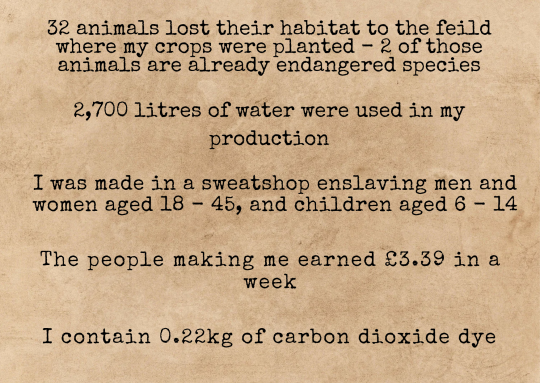
[Image ID: A type-writer font has been used on a brown craft paper background. The text reads: "32 animals lost their habitat to the field where my crops were planted - 2 of those animals are already endangered species. 2,700 litres of water were used in my production. I was made in a sweatshop enslaving men and women aged 16 - 45, and children aged 6 - 14. I contain 0.22kg of carbon dioxide dye." End ID.]
This is a mock-up of a label / statement for a single T-shirt, with researched statistics and educated estimates for the information I couldn't find a calculated answer for.
Now imagine labels / statements like this for every single piece of clothing: how many toxic chemicals are in those new jeans? How many litres of water did that shirt take to make? How many animals were skinned to make those cute fur-trimmed boots? How many children made that jumper? How many people were forcibly removed from their homes, so production companies could plant crops to grow the materials used in clothes manufacturing? How many families were evicted for no reason other than corporate greed? How many trees were cut down? How many animals were displaced or killed?
Would you really want to buy those items of clothing if the answers to those questions were staring you in the face?
If this information was stated in clear, accessible ways on both the website and the ticket on the actual garment, this would dramatically reduce the number of people buying fast fashion items. It would also reduce the profits being made by fast fashion companies, and could lead to many of them being forced to choose between changing and becoming sustainable, eco-froendly and ethical brands, or shutting down due to being boycotted.
Who would really want to knowingly buy things that are made by slaves, or which cost a family their home, or which contributed to deforestation? Who would continue to buy fast fashion items knowing this is the damage caused by them, when sustainable alternatives are an option?
Whether it's second-hand fashion at affordable prices, or investing more money in sustainable products which were made with high ethical standards and which cost more money due to the fact their price accounts for the time it took a person to make that item... we can say for certain that sustainable shopping is going to become much more popular if people know how important that change is. Sustainable items last much longer than fast-fashion items, which by design are created to self-destruct, as they are made to be worn a few times and then discarded in order to be replaced by the next trend's items - and as trends speed up, these items become weaker and weaker. This then leads to people spending more money in order to keep up with the newest trends, and to keep replacing clothes they throw out after a few washes.
In contrast, buying sustainable items which are designed to last years means people won't have to spend money on new clothes every few weeks, which means they'll ultimately save money in the long term and actually be able to afford those pricier items which will last much, much longer.
Now, despite the amount of harm the fast-fashion industry causes to people and the environment, the last thing we should be doing is getting angry at those who continue to buy them. Being the target of anger doesn't make large populations change their behaviour - even a cursory look through history books will tell us that much. Neither does being the target of resentment or blame.
But guilt? Shame? Those are two of the most powerful emotions to magnify when you want change to happen in waves.
And frankly, if people feel ashamed of buying something, or if buying something makes them feel guilty... they're going to stop buying it.
Those aren't the only emotions that should be felt, though. Because only feeling guilt and shame leads to feeling hopeless, scared, anxious and depressed. And we don't want that. No matter how bad things get... we don't want that.
The only other emotions to provoke are hope and pride.
If there's no hope for the future, how can anyone be expected to imagine a better one?
You wouldn't think it, what with all the climate crises and disasters we experience around the world and the total lack of commitment made by billionaires, multimillion-dollar companies and corporations and politicians.
But it's true. Scientists in Scotland have discovered bacteria which eat plastic and speed up the decomposition of it. ‘Ecocide’ is now punishable by law. Some countries within the EU are already close to meeting their 2030 goals years ahead of schedule! Thanks to scientists and small, individual changes made on a massive scale by ordinary people who are making small adjustments to our everyday choices, we can and are healing most of the ozone layer before 2050. That is something we should all feel incredibly proud of.
So imagine how much we could speed that process up if more people made those changes. Imagine how much sooner we could heal our planet if billions of people made those changes, rather than millions. Imagine how much sooner we could be seeing the effects of a healthier planet if fast fashion companies were forced to choose between going green and transparent, or closing altogether due to a lack of interest from consumers. Imagine the changes we could create if corporations made massive changes in a short amount of time, in order to save their own profits.
Imagine more labels like this, sitting alongside each other on every single piece of fast fashion clothing. A statement like this beneath every item of clothing on fast fashion websites, which transparently states the harm done.
If every single fast-fashion company and store had to display this on their clothing, on their racks, on their websites, and if there were legal punishments for those who tried to evade or lie... fashion would turn a lot greener very quickly. We'd start seeing more and more labels with "I'm made from 6 plastic bottles! I used to be a newspaper! I had 0 pesticides used on me in my production! I only contain natural dye made from berries, beans and sustainably grown flowers. I was made from apple skins and corn! The people who made me get to go home to their families every night, have days off and the adults made £150.35 each in 1 week! The animal who made the wool for me is free-range and well-cared for! I came from a small family farm, and was created with a closed-loop water system!”
That'd be a much better civilisation to shop in, don't you agree?
That is hope for the future.
That is motivation, which can fuel ordinary people to do extraordinary things and create changes they thought were impossible.
If you want to be a part of creating this change, sign the Change.org petition which demands the the creation and implementation of an international law which will require all fast-fashion products to be displayed with a statement which states the harm done to people and the planet by that garment being made & shipped.
#fast fashion#fashion#climate crisis#climate change#climate action#climate catastrophe#environmentalism#environment#environmetalists#enviromental#sustainability#sustainable#economy#ecofriendly#ecosystem#europe#earth#ecommerce#society#socialist#sociology#social justice#social media#slave labor#children#child labor#children's rights#environmental justice#petition#petitions
27 notes
·
View notes
Text
Ways People Will be Killed by Climate Change:
-Thirst: Amnesty International says 2 billion people will see their water access severely and incredibly diminished. In the Horn of Africa, people are only finding 1/4 of the water they had before.
-Hunger: Many people will die from malnutrition. Many more people will die from chronic undernutrition. So many sources I have read have stated that food supplies will greatly diminish due to climate change. This will be due to an increase in floods, rising sea levels eating up land and causing salinity in the dry land that remains, increased droughts, dry places getting too dry and wet places getting too wet, overheating, storms, extreme weather, unpredictable weather, a decrease in soil fertility caused by loss in biodiversity, cold snaps coming earlier and earlier into the growing season in northern countries, erosion washing away farmland, increased pests due to the inability of the environment to control pests, the list goes on. 345 million people worldwide already have acute (not moderate, not high, but acute) levels of hunger, in large part due to climate change.
-Heat Waves: Over 1.5 billion people live in places where they constantly face the upper limits of heat that the human body can tolerate. As the earth warms, heat waves will become far more frequent and many people will die from them.
-Cold: As the polar vortex becomes looser and looser, many more people in the more northern parts of the world will be subjected to extreme cold and will die due to it, especially poor people.
-Natural Disasters: Storms, floods, fires, tornadoes, hurricanes, landslides, and more will greatly increase in both frequency and severity, killing many people.
-Poverty: More than 100 million people will be pushed into extreme poverty by 2030 alone due to climate change. By 2030 alone, and this number will only increase as time goes on. Note here that I said extreme poverty. Not multidimensional poverty, which is also very deadly and torturous, not acute multidimensional poverty, which is incredibly deadly, but extreme poverty, the worst form of poverty of all. Even greater numbers of people will be pushed into multidimensional and acute multidimensional poverty.
-War: As resources dwindle, there will be wars over the little remaining fertile land, the little remaining water, the few remaining pastures. These wars will also get many people killed.
-Far Right Extremism: Increased displacement, climate refugees (due to the crowding of people into areas that are still cool enough to live in, because many places, like Australia, will become too hot to sustain human life), decreased wealth flowing to the middle class, and other factors will increase fascism and far right ideology. This will lead to increased hate crimes, perhaps greatly so, and this will lead to more people dying.
-Epidemics, pandemics, new and old diseases: As the capacity of the environment to do pest control decreases, disease carriers will increase and diseases like malaria, Dengue fever, West Nile virus, and more will increase. As natural spaces get degraded, animals will become less healthy and diseases among animals will increase. This will lead to an increase in new diseases crossing over from animals to humans and to an increase in new diseases being created in animals.
-Homelessness: As more people lose their homes due to storms, floods, and other natural disasters, there will be an increase in homelessness and more people will die due to the risks of being unhoused.
-Suicide: The degradation in natural spaces will cause mental health among members of communities that are closely tied to the natural environment to worsen, leading to increased suicides. This will be amplified due to the fact that communities closely tied to the environment such as Indigenous communities and Afro-Latino communities are often already marginalized and already face risks to their mental health. Like for example most members of the religion I am a part of already have at least one mental illness, and we rely on our connection to our Parent, the earth, to help us heal ourselves and build better lives for ourselves and our children. If the earth is dead many of us will be too. And we’re actually really privileged compared to say, Indigenous people (though some of us are Indigenous but not me), so imagine how much worse it would be to be part of an even more marginalized group that is closely tied to the environment.
-Pollution: Increased use of fossil fuels will lead to increased air pollution. 9 million people already die each year due to air pollution. This will only grow worse as the amount of greenhouse gases and other harmful gases builds up in the atmosphere.
-Not Having Enough Nutrients: Calories aren’t the only thing the human body needs, nutrients are incredibly important too. The climate crisis will destroy the health of the ocean, due to acidification, rising water temperatures, and changed weather conditions and water flow. This will kill many fish. 3 billion people rely on fish for their main source of protein, because of how cheap it is compared to other sources of protein. Many of these people will not be able to get the fish they need and will lack the vital nutrients the fish provide them, which will lead to many deaths.
-Decrease in Social Cohesion: The natural environment teaches so many of us to be good people. Without healthy nature, many of the new generations won’t take into their souls the necessity of helping each other. If less of us help each other, more people will die.
I’m going to get a bit religious now. So look at this paragraph with an open mind. The earth is our Parent, who we all came from and who we all live on. If the earth is unhealthy, the people will be too, and if the people are unhealthy, the earth will be too. Like any healthy parent-child relationship, our well-being is tied into Their well-being and Their well-being is tied into ours. But it’s not just my religion that says that the people need a healthy planet, it’s many religions all over the world. And it’s not just many religions all over the world that say this, but science says this too. So if you care about social justice at all, you have to care about climate change.
#climate change#climate crisis#climate justice#climate disaster#climate chaos#climate#climate catastrophe#environnement#environmental issues#enviromental#poverty#inequality#equity#inequity#mental health#health#health and wellness#war#peace#social justice#social change#change#social issues#economic justice#humanity#human rights#human nature#nature#support bipoc#bipoc lives matter
204 notes
·
View notes
Text
polar.mp4
youtube
Goodbye bear.
#polar.mp4#polar bear#polar bears#bears#climate change#climate action#nature#climate disaster#climate crisis#climate emergency#global warming#climate catastrophe#environmentalism#fossil fuels#politics#us politics#art#my art#artwork#climate activism#climate activist#polar bear fan club#polar bearz#bear lover#Youtube
9 notes
·
View notes